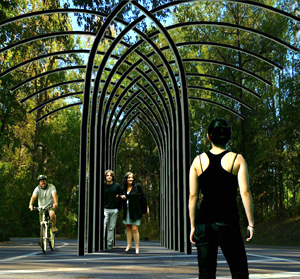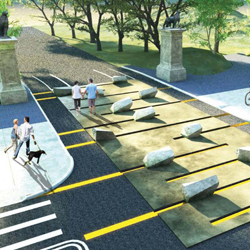
Evoking the tranquility of a Japanese rock garden — albeit at a much larger scale — the Stone Garden concept by Jordan Yamada and Peter Zaharatos was recently named the winner of the Park Slope Civic Council’s Prospect Park Gateway Design Competition.
The two New York City-based architects were honored at this month’s Civic Council trustees meeting for their efforts on a new entrance design for the park at Third Street. They were joined by two runners-up, recent architecture-school graduate Ivan Himanen and footwear designer Kevin Dohn, as well as 13-year-old Park Sloper Rowan McAllister, who received an honorable mention.
“We were very pleased with the quality of the entries,” said Civic Council Second Vice President and architect Gilly Youner, who organized the competition and served as a juror and chair. “Everyone who entered put a lot of thought into the project and a lot of creativity. They came up with a wide variety of answers to the same challenge.”
That challenge was to design a new gateway into the park where Third Street meets Prospect Park West. Right now, the two tall statues of proud panthers overlook a dingy set of police barricades that hold up an unwelcoming “DO NOT ENTER” sign. “People have been complaining about the decrepit look of the barricades,” said Youner, “especially now that they seem to be permanently positioned at the Third Street entrance.”
Any design also had to let emergency vehicles — but not other vehicular traffic — enter the park, allow easy access for pedestrians and bicyclists, be safe and sturdy, and use be economical to build.
The winning concept “created a zone that would slow traffic and create a contemplative space, letting people transition from vehicular traffic outside to the quiet park,” said Yamada. The team’s Stone Gardens proposal calls for large, rough, movable sculptural rocks on tracks in front of the Third Street entrance. The “boulders” would serve as a barrier to normal traffic, but could be pushed along the tracks to permit emergency entry.
Park-goers could also move the rocks themselves, creating a new, interactive experience for visitors. The tracks would be lit at night.
“We wanted to put together something that wouldn’t be obtrusive to the overall look of the park,” said Zaharatos. The team was inspired by the peaceful space of a Japanese rock garden or Zen garden, as well as by sailing stones, the phenomenon found in Death Valley, Calif., in which rocks seemingly move on their own and leave long tracks across the desert floor.
Yamada and Zharatos, who earned a $2,000 prize for their efforts, first met when they were at separate firms working on the design for the New York City Police Academy in Queens. Yamada is still with the firm of Michael Fieldman, while Zaharatos has since left Perkins & Will for private practice.
Youner feels the jury “liked the idea because it lent itself to being more of a landscape rather than a barrier, giving a natural sculptural sense to the area.”
Runner-up Dohn’s idea for the contest, called “The Tree Grove,” took another approach to the problem. He designed a tall, treelike recycled-aluminum gate that can swing open when needed, and leaves a lot of room for pedestrian and bicycle access.
“I was looking for something that respected the historic-district nature of area,” he said. “I also wanted to bring in a European influence into the area, something that combined the rigid iron railing found in the community with more organic forms found in the park.

“I like the idea of walking through that entrance and having something that gave a good initial transition from the outside into the freer feel of entering the park,” added Dohn, who was excited about the possibility of contributing something in his neighborhood.
Youner echoed the excitement. “Tree Grove was another strong aesthetic favorite of the jury, who felt its scale and grace would work in several park entrances, though one concern was how a feasible structural solution would affect the beautiful latticelike effect of the submitted design.”
Himanen, meanwhile, didn’t “want to just settle on a gate swinging open, which would need rails, digging, and could become a hazard for bicyclists and kids.” Instead, his “3rd Street Arches” is comprised of 16 tubular-steel partial arches shaped like lowercase “r”s, permanently installed in the roadway, that alternate direction from left to right. When seen from the entrance, the structures would look like an arched “T” or a simplified metallic willow tree.
“The solution was more an expression of a gateway,” he said, “rather than something that functioned with moving parts.” The arches, he added, would be light and easy to build.
One highlight of this design for jurors was the “particularly lovely effect of night lighting concealed within the arches.” At night, Himanen said, “the pathway could still be used, and would be safer and more attractive.”
Each runner-up earned a $500 prize.
McAllister, the youngest to enter the competition, wanted his design to be a fancier model of the barricades now in use and symbolize how people use the park year-round. His design involves four metal trees — one with a green top, one orange, one with no leaves, and the last green again — to mark the four seasons, surrounded by a park-drive-shaped loop. The center trees could swing open for any emergency access.
The design started as so many designs do: “I came up with the idea on my own,” he said, “then drew it on a party napkin.” He made a cleaner version, and then worked with his mother to finalize the entry.
McAllister’s favorite subjects in school are science and art, which should serve him well in one possible career in the future: a Hollywood set designer. “You have to be more creative to build an alien set for a sci-fi movie.”
The design challenge received entries from 12 individuals and groups, who submitted 16 different designs. The jury had to review all of them. “We had some very strong opinions,” Youner said, “and everyone enjoyed looking at the images with different points of view.”
Joining Youner on the panel of judges were: Sally Gil, an artist in Park Slope; Laurie Hawkinson, partner, RA, Hawkinson Smith-Miller Architects); Marc Littlejohn, product designer; Aaron Naparstek, of Streetsblog, Park Slope Neighbors, and the Grand Army Plaza Coalition; Nancy Owens, ASLA, LEED AP, and principal, Nancy Owens Studio LLC; Josephine Pittari, senior vice president of operations for Prospect Park; Rob Witherwax, coordinator, Grand Army Plaza Coalition; and Christian Zimmerman, vice president of design and construction for Prospect Park.
“I came away from the jury discussion with the idea that a lot of these designs would be wonderful as sculptural installations even if they didn’t become gateways,” Youner noted. “The common ground for the winning design was that it included elements that appealed to the widest range of jurors.”
She added that Yamada and Zaharatos are looking to get a partial prototype of their design built and placed in a publicly viewable installation. Modifications suggested by the jurors for Stone Gardens would be to have only one or two stones movable and the rest in a fixed position, which would reduce maintenance on the track mechanisms; also, the entire design should be moved further into the park for greater safety.
In addition to the many designs, Youner said, “the competition was successful because of the interest it generated. It got many people to think of how to work creatively within their community and with the Civic Council.”
— David Herman
from the December 2010 Civic News

